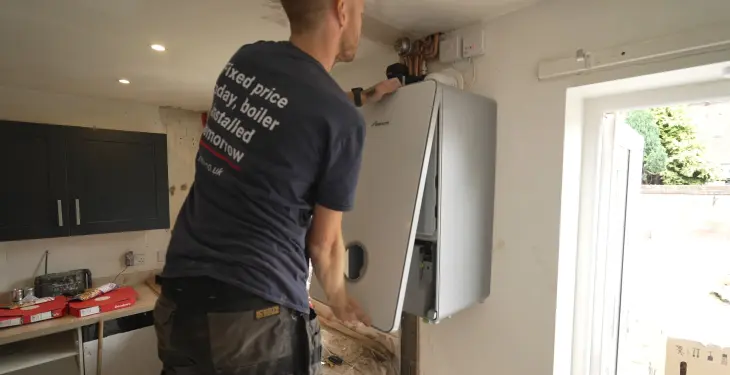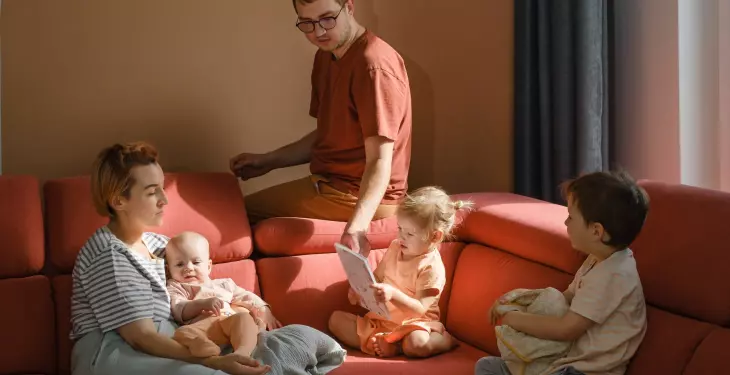

Written by Stephen Day
Gas Safe Engineer
Updated: 30th May, 2025
Boilers can produce carbon monoxide (CO), a dangerous and potentially deadly gas, through the process of burning fuel. It's essential to understand how CO is generated, especially with combi boilers, and why maintenance is key to safety.
Get a new boiler quote, save up to £550 per year (0% APR available).
When it comes to ensuring the safety of your home, questioning if a carbon monoxide detector is needed with a combi boiler is vital. Yes, installing a carbon monoxide detector is crucial to protect against this hidden danger. Even though modern combi boilers are designed to be highly efficient and safe, the risk of carbon monoxide (CO) poisoning, though minimal, still exists.
Carbon monoxide is a silent killer. This colourless, odourless gas can cause severe health problems or even death if undetected. Houses in the UK equipped with gas appliances, including combi boilers, should always have a functional carbon monoxide detector. It’s a small investment for your peace of mind and family’s safety.
Legal requirements also support this safety measure. The UK government mandates that landlords must install CO detectors in properties with gas appliances. Homeowners are encouraged to take this preventive step too. The right detector, installed and maintained correctly, could be a lifesaver.
Get a quote in 60 seconds, fitted as fast as next day!
0% APR finance available.
Carbon monoxide (CO) is a dangerous gas that is both invisible and odourless. It's crucial to understand its characteristics, the health impacts it can have, and the sources of CO in homes, especially when using appliances like a combi boiler.
Carbon monoxide is a colourless, odourless, and tasteless gas. This means it is impossible to detect without a proper alarm.
It is produced when fuels such as gas, wood, coal, or oil do not burn completely. Because CO is lighter than air, it can easily spread throughout the home very quickly.
Exposure to carbon monoxide can cause a variety of health issues. Even low levels can lead to headaches, dizziness, nausea, and vomiting. With continued exposure, symptoms can escalate to shortness of breath, chest pains, or even collapse.
High levels of carbon monoxide can cause loss of consciousness and potentially death. The elderly, young children, and pets are especially vulnerable to CO poisoning.
Carbon monoxide can accumulate in homes from several sources, particularly those involving fuel combustion. Common sources include:
Gas boilers: Including combi boilers, if not installed or maintained properly.
Gas ovens and stoves: These can emit CO if not vented correctly.
Wood or gas fireplaces: Blocked or inadequate chimney ventilation can cause CO buildup.
Portable generators and petrol-powered tools: These can produce CO, especially if used indoors or in poorly ventilated areas.
Using these appliances requires careful monitoring and maintenance to ensure they do not become CO hazards. Proper ventilation and regular inspections are essential to prevent CO poisoning.
Awareness of these characteristics, impacts, and sources is vital for anyone using a combi boiler or other fuel-burning appliances. Proper precautions and a reliable carbon monoxide detector can significantly reduce the risks associated with this dangerous gas.
Boilers can produce carbon monoxide (CO), a dangerous and potentially deadly gas, through the process of burning fuel. It's essential to understand how CO is generated, especially with combi boilers, and why maintenance is key to safety.
Carbon monoxide is produced during the incomplete combustion of fuels such as gas, oil, wood, and coal.
Boilers that are not burning fuel completely will create CO. This can happen if there is not enough oxygen during the combustion process.
In a properly functioning boiler, carbon monoxide should be vented outside through a flue. If the flue is blocked, leaks can occur, causing CO to enter living spaces.
Combi boilers combine central heating and hot water functions in one unit. They are fuel-burning appliances that can produce CO if not functioning correctly.
Since combi boilers are used frequently, the risk of CO production is heightened. Blocked flues and improper ventilation can cause dangerous CO levels.
Installing a carbon monoxide detector near your combi boiler is crucial to detect leaks early. Building regulations in the UK require CO alarms in rooms where fuel-burning appliances are installed.
Regular boiler maintenance is vital in preventing carbon monoxide leaks. An annual service by a qualified engineer ensures that all parts are working correctly.
Maintenance should include checking the flue for blockages and ensuring proper ventilation. Even with a CO alarm, regular servicing is the best way to prevent CO problems.
Proper maintenance covers all fuel-burning appliances, including gas fires and stoves, reducing the risk of CO exposure.
The UK has specific legislation and guidelines for carbon monoxide alarms, especially in rented properties. These rules are crucial for the safety of residents and impose clear duties on landlords and managing agents to ensure compliance.
In the UK, The Smoke and Carbon Monoxide Alarm (Amendment) Regulations 2022 require that all rooms with a fuel-burning appliance, such as a combi boiler, must have a carbon monoxide alarm. This regulation applies to both private and social landlords. The rules are designed to prevent carbon monoxide poisoning by detecting the gas early.
The regulations came into effect on 1 October 2022 and cover rented properties including houses, flats, and Houses in Multiple Occupation (HMOs). Local authorities can issue remedial notices to landlords who fail to comply, and enforcement action may follow if the landlord does not take corrective steps.
Landlords and managing agents have several responsibilities under these regulations. They must ensure that a carbon monoxide alarm is installed in any room where there is a gas appliance, which includes combi boilers. Additionally, they must act promptly if a tenant reports a faulty alarm, providing repairs or replacements as needed.
Private landlords and social landlords must also check that the alarms are in good working order at the start of every new tenancy. This responsibility includes student halls of residence and other rented accommodations covered by the legislation. Failure to comply can result in fines or enforcement actions by local authorities.
When selecting carbon monoxide detectors, it is important to adhere to approved standards. Detectors should be kitemark certified to ensure they meet British safety standards. The alarms must also be placed correctly, usually at head height and 1-3 metres away from the potential source of carbon monoxide, such as a combi boiler.
Landlords are advised to use alarms from reputable brands and to ensure they are installed by Gas Safe registered engineers. Regular maintenance and testing of the alarms are crucial, and tenants should be informed about how to test and maintain their detectors themselves.
Following these guidelines can help protect residents from carbon monoxide poisoning and ensure compliance with UK regulations.
When choosing a carbon monoxide detector, it's important to know the types available and the features that will ensure safety and reliability. Proper selection can provide peace of mind and protection against this silent threat.
Audible Alarm DetectorsThese detectors are designed to alert you with a loud sound when they detect carbon monoxide. They are similar to smoke alarms and are the most common type. You should place them in areas where audible alerts can be easily heard, such as near bedrooms.
Digital Display DetectorsThese detectors not only sound an alarm but also provide a digital readout of the carbon monoxide levels. This can be useful for understanding the severity of the situation and taking appropriate action. They are slightly more expensive but provide additional information.
Battery-Operated DetectorsThese can be installed anywhere and are not reliant on mains power. It's critical to test these detectors regularly to ensure the batteries are in good condition. Some models come with a long-life sealed battery, which can last up to 10 years.
Power SourceDetectors can be powered by batteries or by being hardwired into your home’s electrical system. Battery-operated detectors offer flexibility in placement, while hardwired versions ensure you don’t have to worry about dead batteries.
Alarm Sound and VolumeThe alarm should be loud enough to wake you, especially if it goes off at night. Check the decibel rating which typically ranges from 85 dB to 100 dB. The higher the number, the louder the alarm.
Display and AlertsA detector with a digital display can show the carbon monoxide levels in real-time. This feature allows you to see the rise and fall of CO levels over time. Some detectors also have visual alerts like flashing lights in addition to the audible alarm.
Ease of InstallationSome detectors can be simply mounted on a wall or placed on a shelf. Ensure they are installed according to manufacturer instructions, usually away from appliances that may cause false alarms.
Testing and MaintenanceRegular testing of your detector is essential. Most models come with a test button that lets you check if the alarm is working correctly. Keeping the detector clean and dust-free can also help maintain its effectiveness.
Correct placement and installation of carbon monoxide detectors are crucial for ensuring safety from this invisible, life-threatening gas. Follow these guidelines to place and install your detectors effectively.
Carbon monoxide alarms should be placed in key locations within your home. Position them near gas appliances like boilers and cookers to detect leaks early. It's recommended to install detectors in every room containing a gas appliance. In addition, place detectors in living areas and sleeping spaces to ensure comprehensive coverage.
Avoid placing detectors directly above a source of heat or steam to prevent false alarms. Install alarms at head height for effective detection, either on the ceiling or on a high shelf. This setup is important because carbon monoxide mixes evenly with air, requiring detectors to be at breathing height for accurate readings.
Locations to consider placing carbon monoxide detectors:
Near gas boilers and cookers
Living rooms and bedrooms
Hallways or landings outside sleeping areas
Proper installation involves following the manufacturer's instructions carefully to ensure the detector functions correctly. Position the alarm approximately 15 centimetres from the ceiling and at least 1 metre away from any gas appliances.
Do not install the alarm in bathrooms or other damp areas as moisture may interfere with its operation. Additionally, avoid placing it directly next to windows or ventilation units to prevent dilution of carbon monoxide levels and false readings. Ensure the detector is not obstructed by curtains or furniture.
Key points for installation:
Follow manufacturer’s guidelines
Install at head height, around 15 centimetres from the ceiling
Keep at least 1 metre away from gas appliances
Avoid humid and drafty areas
Regularly test your detectors according to the manufacturer’s instructions and replace them as per the recommended schedule to maintain safety.
Proper maintenance and regular testing of carbon monoxide (CO) detectors are essential for ensuring their functionality and safety. Neglecting these can lead to dangerous consequences. This section will cover routine maintenance procedures and the steps to test CO detectors to keep them in optimal working condition.
Routine maintenance of CO detectors involves regular checks and simple tasks to keep the device in good working order. Cleaning the detector is important. Dust and debris can interfere with its ability to detect CO. Use a soft cloth and avoid using water or cleaning agents.
Check the batteries regularly, even if they are designed to last long. Replace them according to the manufacturer's recommendations. Many modern detectors have a low-battery alert; don’t ignore this warning.
Inspect the expiry date on the detector. Most CO detectors have a lifespan of 5-7 years. Replace the unit if it has passed its expiry date or shows signs of malfunctioning.
It’s also wise to test the device weekly to ensure it is functioning correctly. Follow the instructions in the user manual for specific details on how to perform these checks.
Testing a CO detector is straightforward but critical. Use the test button on the device to check its functionality. Press this button, and the alarm should sound if the detector is working properly.
For more thorough testing, use a CO detector test kit. These kits release a controlled amount of CO to see if the detector responds correctly. Follow the instructions carefully to ensure accurate test results.
Pay attention to alarms and error messages. If the detector alerts you to a problem, take it seriously and either replace the unit or consult a professional.
In addition, place CO detectors away from potential obstructions. Keep them at recommended locations as specified by safety guidelines, ensuring they are not covered or blocked.
Regular testing and maintenance can significantly reduce the risk of CO poisoning, maintaining a safe environment.
Having an action plan is essential to ensure the safety of all residents in case of carbon monoxide exposure.
If a carbon monoxide alarm goes off, it's critical to act immediately. First, do not ignore the alarm, even if you feel fine. Carbon monoxide is a tasteless, odourless gas, and symptoms can escalate quickly.
Second, evacuate everyone from the premises and move to a location with fresh air. Leave windows and doors open to help ventilate the area.
Third, avoid using any electrical devices or open flames as these can create sparks.
Finally, contact a Gas Safe registered engineer to inspect and fix the source of the carbon monoxide leak. They can also check other potential sources to ensure complete safety.
If anyone in the household shows symptoms of carbon monoxide poisoning, such as headaches, dizziness, confusion, or loss of consciousness, seek medical attention immediately. Take the affected person to the nearest hospital or call emergency services.
Report the incident to the National Gas Helpline for further advice and support. They can guide you on the necessary steps and provide additional information to prevent future incidents.
Also, inform your landlord or property management if you are renting. They are required by law to ensure the safety of the property, including the proper maintenance of gas appliances and detectors.
Different energy sources can produce carbon monoxide, making CO detectors essential for various fuel-burning appliances.
Gas boilers are common in many homes. These appliances can leak carbon monoxide if not properly maintained. Oil and LPG boilers also pose similar risks.
Solid fuels such as wood and coal can produce carbon monoxide when they burn. This applies to fireplaces and stoves.
Fuel-burning appliances need regular checks. Faulty equipment increases CO risks.
Modern combi boilers are safer than older models. However, it's still important to install a carbon monoxide detector.
For gas, oil, and LPG systems, a carbon monoxide detector helps alert homeowners to leaks. Proper ventilation is vital.
Solid fuel users should also use detectors. This includes wood burners and coal stoves. Install detectors close to sleeping areas for early warning.
Regular maintenance is key. Hire professionals to check your appliances at least yearly.
Place CO detectors according to manufacturers' guidelines. Usually, they should be near bedrooms and fuel-burning appliances.
Following these guidelines can help ensure safety from carbon monoxide exposure.
New boilers can be a daunting purchase for many people as they’re an appliance with a lot of responsibility, providing heat for you and your family is something you want to get right. Boilers aren’t exactly a quickly disposable item either, potentially lasting you a decade.
Effectively, new boiler cost can be split into two segments: the first is the actual boiler itself (unit price), and the second is the cost of the boiler being installed (set up) in your property by an expert engineer.
Here at iHeat, we remove all of this undue stress and make the decision making process of upgrading to a new heating system, as easy as possible.
New boiler costs can vary depending on a number of factors including their brand, model, fuel, output, warranty, labour and boiler installation type. Typically a new boiler will cost between £1,845 and £3,500, below is a list of average boiler installations offered by iHeat (guide only).
Installation Type | Price (inc VAT) | |
Combi to combi swap | £1,845 | |
System to combi conversion | £2,499 | |
New boiler install | £2,899 | |
Back boiler to a combi | £3,299 | |
System to system | £1,945 |
Last updated: 30th May, 2025

Written by Stephen Day
Gas Safe Engineer at iHeat
Stephen Day is a Gas Safe registered and FGAS certified engineer with over 20 years of hands-on experience in the heating, cooling, and renewable energy industry, specialising in boiler installations, air conditioning, and heat pump systems.
LinkedInArticles by Stephen Day are reviewed by iHeat’s technical team to ensure accuracy and reliability.

22nd December, 2025
Based on data from over 7000 boiler installations completed by iHeat in the past 12 months...
 Read Article
Read Article

22nd December, 2025
Here’s a quick roundup of the best combi boilers for 2026.
 Read Article
Read Article

22nd December, 2025
When your old boiler breaks down and it comes time to replace it with a new one, it might...
 Read Article
Read Article
No obligation. Takes less than 60 seconds.